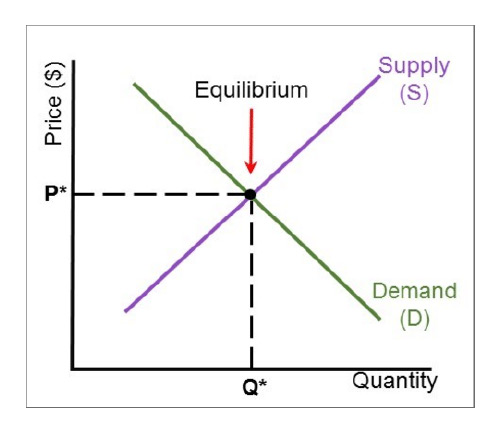
When making important business decisions it is critical to evaluate them in economic terms, oftentimes boiled down to supply and demand. According to www.investopia.com[1], demand is an economic principle referring to a consumer’s desire to purchase goods and services and their willingness to pay a price for a specific good or service. Holding all other factors constant, an increase in the price of a good or service will decrease the quantity demanded, and vice versa. Another way to say this would be the reduced supply of a widget raises the price (value gets higher). Conversely when there is more supply in the market the value of the widget goes down. When the equilibrium of supply and demand is disrupted, the consumer often loses, and businesses struggle to survive. When perfect equilibrium is achieved all parties are better off.
In today’s healthcare system in the US, we have a major supply and demand issue on our hands. Demand for services has increased exponentially, supply has struggled to keep up, and in many cases, prices charged are not directly connected to the supply in the market. The healthcare system in the US was created with a Fee for Service (FFS) mentality where services are delivered when someone wants or has a need to consume care. Decisions often have little to do with what care should be optimally provided. When supply is not able to keep up with demand, quality often goes down, and with that, the overall cost of care increases. Healthcare has many abnormalities that make it hard to directly correlate it to normal economic supply and demand. It has been said that health care does not operate by the traditional supply-demand economic model.
This section is going to look at many things that affect supply and demand in healthcare.
Supply
- Consolidation- Unprecedented consolidation in the healthcare space has led to less inter-company competition.
- Shortage of Doctors- There supposedly is a shortage of doctors in the US and leads to a shortage of available appointments and the ability to get the care that is needed or desired.
- Shortage of PCPs- There is especially a shortage of primary care physicians. Efficient healthcare systems rely on PCPs to help manage and direct care. In the absence of accessible PCPs, utilization increases.
- Oversaturation- In some regions supply has been ignored and oversaturation has led to increased demand.
- Limited Access- Less accessible regions have led to fewer health issues being diagnosed and also less preventive care consumed.
- ER Usage– Under-supply of office visits has led to increased ER usage for things that should be considered as Primary Care. ER has become a “no appointment necessary” office visit and no longer only for life and limb threatening conditions.
Demand
- Aging Population– people are living longer and as your age increases your demand often increases. It is not just the utilization that increases, but also the acuity of the services consumed.
- Chronic Conditions- more and more people have chronic conditions that drive the demand for services.
- Low percentage Uninsured– Since the passage of ACA, 20 million people have been added to the insured populations. This is a social good but it also has increased the demand on the traditional healthcare market.
- Government Subsidies- There are now subsidies available to people where they can get insurance coverage that they had not been able to before.
- More is Better- There is a more is better philosophy in healthcare where people want to consume more care instead of the best care. When utilization rises, so does demand.
- Inelastic Demand– The demand curve for healthcare sometimes ignores cost as people are willing to consume care that they think will help then at whatever cost.
- Health is an Investment– A person’s health cannot always be looked at as a widget, it is an investment and people spend differently when they believe there is going to be future returns.
- Fee for Service– Doctors are often more knowledgeable about the health issues than the patient and they can not only recommend, but also perform services. There are misaligned incentives were a doctor that is creating supply is also able to create demand. The Hippocratic Oath places patient’s health at the front of all healthcare decisions, but hard for practitioners to always remove financial motivation.
- Payer / Member Issue– There is a disconnect with the decision-maker and the payer (insurance company). Oftentimes the member is deciding based on cost-share when they are only paying a small portion of the bill. Having an Insurance policy can increase demand.
- Public Good– System does not allow for turning people away from certain institutions (ER).
“Since the passage of ACA, 20 million people have been added to the insured populations. This is a social good but it also has increased the demand on the traditional healthcare market.”
Resource Planning helps solve Supply and Demand in Healthcare
When it comes to healthcare, there is often very little time spent on system-wide planning, especially between competing systems. When it comes to hospital planning, there seems to be a competition to have the newest and nicest and not much concern for what may be needed in the market. The healthcare market space has become consumed with what members want, and not always what they need. I recently heard a story of a multi-million dollar donor to a hospital who forced the delay of the opening of a new wing because he believed the TVs were too small. He insisted that 50inch TVs were the smallest that should be allowed in each single capacity room.
Physician practices are opened more by where a physician wants to live, compared to where their services might be most needed. Physicians are willing to look long term and plan to build the practice up over time rather than strategically planting where supply is most needed.
When physicians and health plans can step outside the FFS mentality they often look much more closely at the supply and demand in the regions where they operate. Take for instance a major HMO on the west coast that owns all their physicians and hospitals. They do not take the “if we build it, they will come” philosophy, but rather they go into the markets where they currently have patients and learn about their needs. When appropriate this plan expands with more facilities and physicians. When using this approach, they look at the utilization patterns of their current members and reverse engineer what they need to establish to be efficient. In this fashion you can end with the right number of MDs, the right number of beds, the right number of MRI machines, and are can manage and monitor care very efficiently.
Resource planning is an area where Axene Health Partners assists many of our clients. We maintain models that help us better understand the utilization patterns of members and align them with the proper number of practitioners and facility features. For instance, if a new health plan was launching and they planned on enrolling 50,000 members, how many PCP would be needed to adequately cover that population. When shooting from the hip a new health plan might say let’s go sign up 50 PCPs, but the optimal level is somewhere between 25-28. Not only will they potentially be paying too many PCPs, but also by having too many PCPs may lead to lower PCPs engagement as they will need to fill up their patient panel with other unconnected patients. Conversely, sign up too few PCPs and the patients will not be able to get an appointment and therefore their health could be hindered.
When doing resource planning for a new health plan or reviewing a health system it is not just physicians that should be of concern. The plan also needs to look at the number of beds available for acute care stays. The same 50,000 members would on average require between 33 and 38 beds. If the market does not have excess capacity of beds it may not be a market that should be targeted, or if it is trying to partner with a new hospital might be ideal. If a hospital system is looking to open a new hospital, they would be best served looking for areas where the ratio of beds per 1000 people is very low. Sometimes hospitals don’t look at it this way, rather they look at it to take business away from other facilities. The problem is that most of the time two competing 40% full hospitals are not able to run as efficiently as one facility that is 80% full. In some cases, it may make more sense to invest / partner with a current facility rather than building and competing with them.
Proper Resource planning will benefit the entire healthcare system. Members will be happier as they have better access, practitioners will be happier as they can see patients efficiently and be able to improve their health, and hospital systems will be better off as their recourses are being maximized. The healthcare supply and demand curve may not always follow economic principals, but it will be better when doing more planning. Proper planning leads to innovation and thinking outside the box. There may be resources available that may not be maximized like the use of Nurse Practitioners and Physicians Assistants. In markets where physician supply is too low, there may be technology that could be utilized that will allow for virtual visits from other regions and therefore raising the available supply. Some of the Supply and Demand elements listed above cannot be controlled, as they are population-related, but many can be helped through resource planning.
There is considerable evidence that points to supply creating demand in healthcare. Many times, in FFS environments, the mere fact that there is increased supply in a market leads to more demand (services consumed). When there is excess supply, members are more easily able to see practitioners whether they need it or not, and therefore dive up the total cost of care. Most of the time this increased supply does not lead to lower prices as the payment level in the area is already set and is not affected by competition.
Education and Explanation
Corporate planning can only make so much progress towards making healthcare more efficient and affordable. The other priority that needs to come to the forefront is education and explanation. Education/Explanation is important as many do not understand healthcare and how the system works. To many people, a copay is what they believe the cost of a service is, quickly forgetting that most of the burden is on their insurer. People need to be better understand everything from who is a quality physician to how care is paid for. On average 12%[2] of the population of the US works in a healthcare related field, yet I would say that many of those and most of the others in the US do not grasp the US healthcare system as good as they should. Government-run healthcare is not the answer to this problem, as it will only create more issues with supply and demand.
Endnotes
[2] Kaiser Family Foundation
Any views or opinions presented in this article are solely those of the author and do not necessarily represent those of the company. AHP accepts no liability for the content of this article, or for the consequences of any actions taken on the basis of the information provided unless that information is subsequently confirmed in writing.

